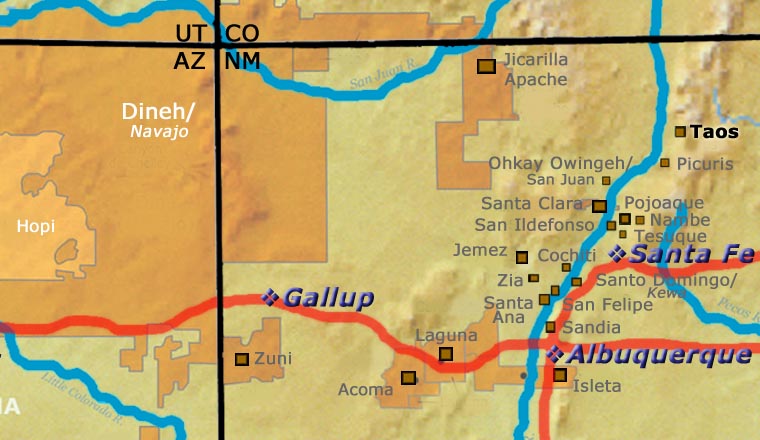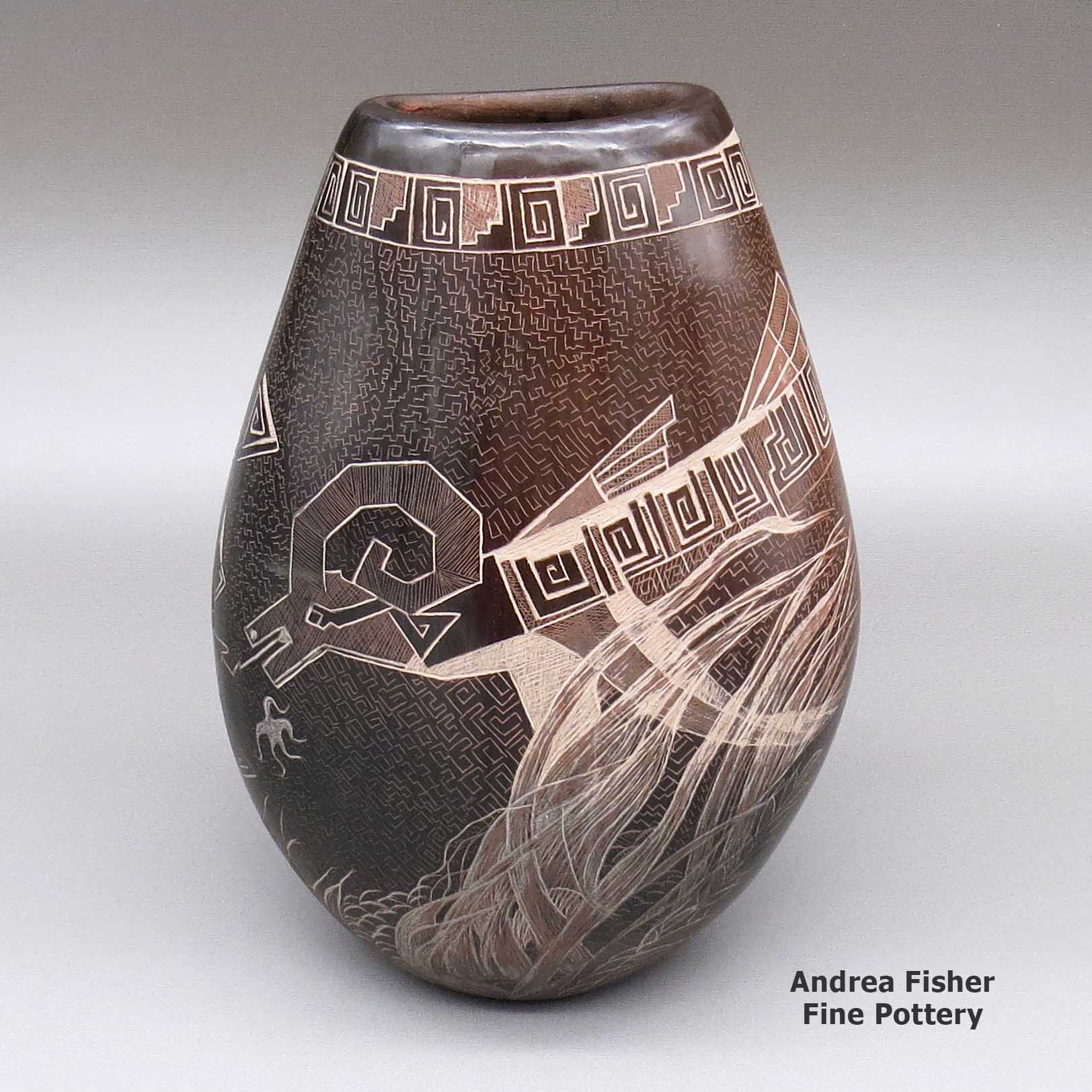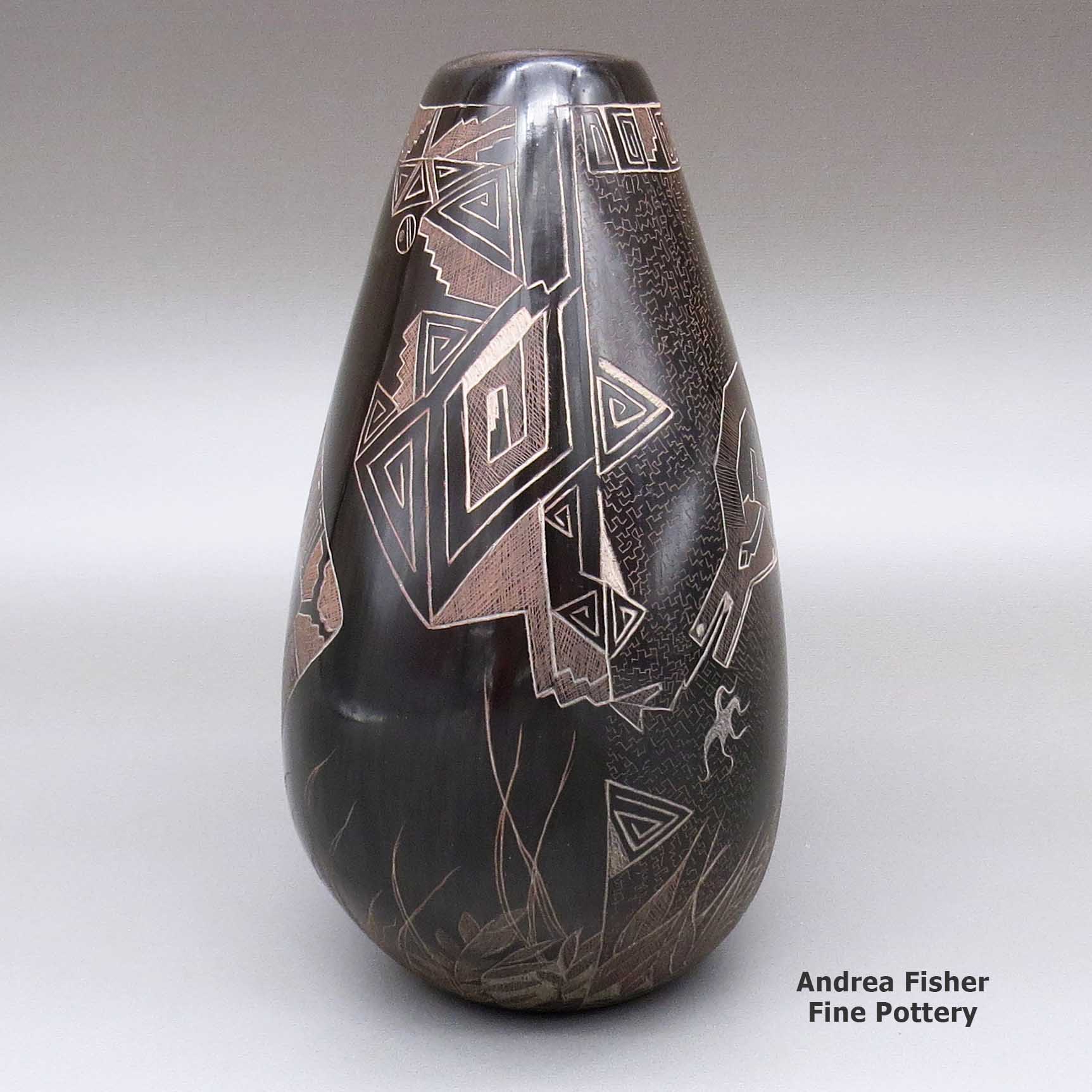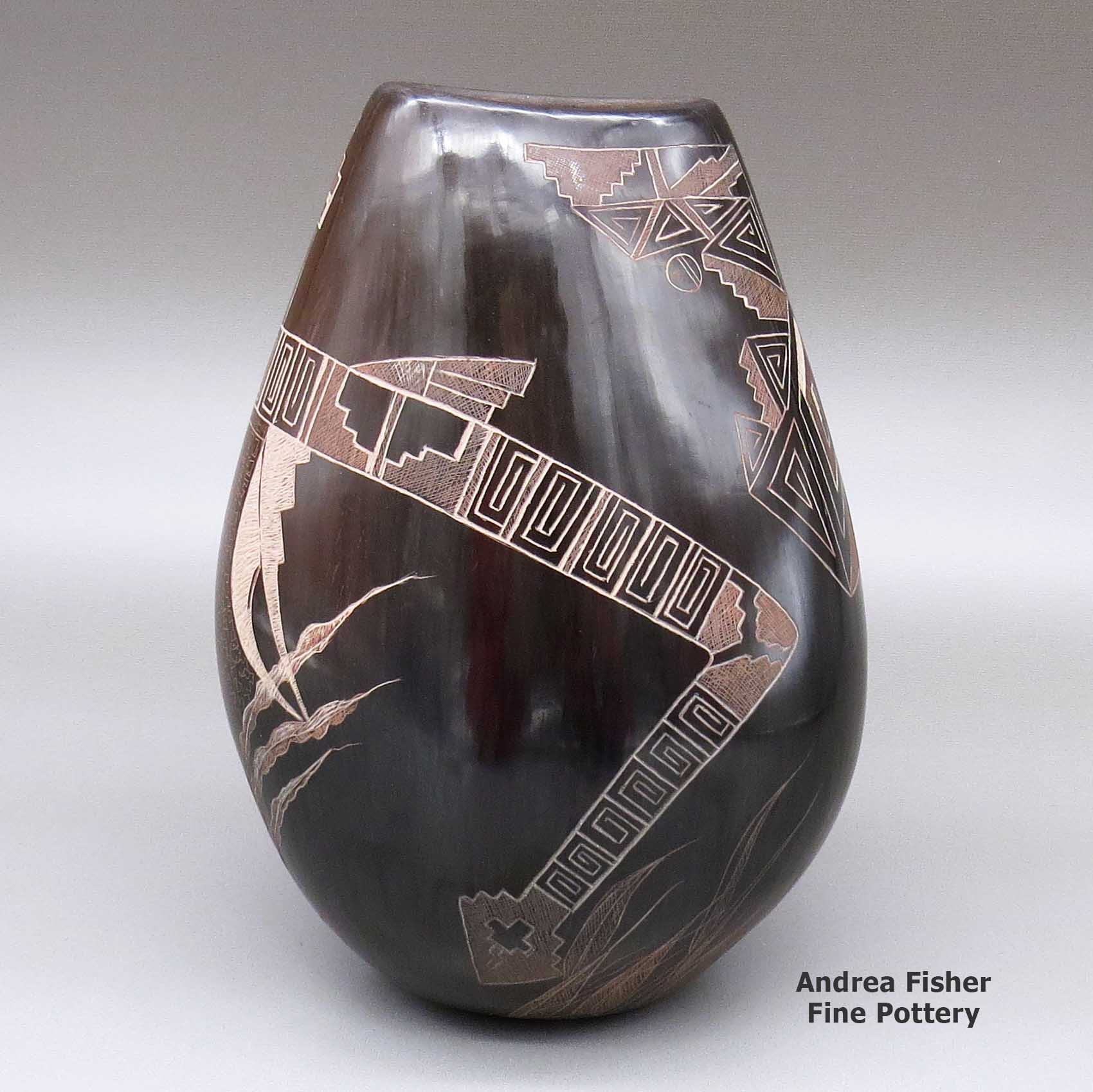| Dimensions | 5.25 × 6.75 × 10.25 in |
|---|---|
| Condition of Piece | Excellent |
| Date Born | 2023 |
| Signature | Her well-hidden BN hallmark |
Bernice Naranjo, zzsc3c100, Sienna jar with a sgraffito avanyu and geometric design
$1,900.00
A sienna jar with an organic opening and decorated with a sgraffito avanyu, underwater scene and geometric design
In stock
Brand
Naranjo, Bernice
At Taos Pueblo, Bernice was a self-taught potter who almost always worked with micaceous clay. At Santa Clara she adjusted her process and learned to work with Santa Clara clay. She is most known for her dark brown and sienna jars decorated with intricate sgraffito designs.
Bernice spent years working out the process to make her trademark sienna/brown jars. It seems they are formed, fired black, etched, then re-fired to sienna. They have earned her numerous ribbons at the Santa Fe Indian Market and the Heard Museum Guild Indian Art Fair & Market.
Some Awards Bernice has earned
- 2019 Heard Museum Guild Indian Fair & Market, Classification II - Pottery, Division G - Pottery miniatures not to exceed three (3) inches at its greatest dimension: Honorable Mention. Awarded for artwork: "Honoring Our Wildlife Environment"
- 2018 Santa Fe Indian Market, Classification II - Pottery, Division C - Traditional Burnished Black or Red Ware; Incised, Painted or Carved, Category 702 - Carved of incised, black or red, over 8 inches: Second Place
- 2017 Santa Fe Indian Market: Classification II - Pottery, Division C - Traditional Burnished Black or Red Ware, Incised, Painted or Carved: Best of Division shared with Dusty Naranjo
- 2017 Santa Fe Indian Market: Classification II - Pottery, Division C - Traditional Burnished Black or Red Ware, Incised, Painted or Carved, Category 702 - Carved or incised, black or red, over 8": First Place shared with Dusty Naranjo
- 2017 Santa Fe Indian Market: Classification II - Pottery, Division D - Contemporary Pottery, any form or design, using Native materials with or without added decorative elements, traditional firing techniques, Category 801 - Sgraffitto, any form: Second Place
- 2004 Santa Fe Indian Market, Classification II - Pottery, Division G - Non-traditional pottery, using traditional techniques and materials, any form or design, Category 1409 - Sgraffito, red or red two-tone: Third Place
A Short History of Taos Pueblo

Taos Pueblo consists of two main structures, both of which are counted among the oldest continuously inhabited structures in the United States. The location straddles the Rio Pueblo de Taos (also known as Red Willow Creek), whose headwaters rise in the nearby Sangre de Cristo Mountains. The pueblo was designated a National Historic Landmark on October 9, 1960 and was designated a UNESCO World Heritage Site in 1992.
The Taos people first figure in the archaeological record about the same time Pot Creek Pueblo burned and was abandoned in the early 1300s. Some of the residents of Pot Creek split from the others and moved northeast to join with and merge into a small Tanoan pueblo located in a perfect spot with a great view. That became today's Taos Pueblo. The native tongue today at Taos Pueblo is Northern Tiwa, a member of the Tanoan family of languages. It is felt the tribe migrated to the area during the time of the Great Drought in the Four Corners region, the same drought that essentially forced nearly all the Pueblo peoples to migrate to the Rio Grande, Rio Puerco or Little Colorado River areas. The people of Taos, though, also feel that some of their people came from the north, which would include possible Jicarilla Apache migrants, and some from the far south, preferably from Aztec or Mesoamerican lands.
On the other hand, Taos was mostly peopled by 7 Jicarilla Apache clans and 6 Tewa clans, in addition to the one or two Tanoan clans left from before the immigrants arrived. For hundreds of years the semi-nomadic Jicarillas came and went from the forests and mountains around Taos, moving with the seasons. They established settlements in the Tusas Mountains and along the Upper Rio Grande. The economies and families of Taos and the Jicarillas were intertwined. Pottery and other trade goods from the region of Taos Pueblo have been found in Dismal River culture sites in eastern Colorado and across Kansas to the Black Hills of South Dakota. The pueblo served as a central contact point between the Rio Grande Pueblos to the south and the Cheyenne, Arapaho, Comanche, Apache and Ute to the north, northwest and northeast.
Around 1620 a Jesuit priest oversaw the construction of the first mission of San Geronimo de Taos. Friction between the tribe and the Spanish led to the killing of the resident priest and destruction of the church in 1660. Priests returned and rebuilt the church only to have the church destroyed again and two resident priests killed in the beginning hours of the Pueblo Revolt of 1680.
The Spanish were evicted from northern Nuevo Mexico in 1680 but returned in force in 1692. By 1700, a third mission church was being built at Taos Pueblo. For a few years the tribe and the Spanish got along, forced to be amicable in order to deal with their common enemies: the Ute and Comanche tribes. That pressure was relieved in 1776 when Governor Juan Bautista de Anza and his troops killed virtually the entire upper hierarchy of the Comanche tribe in the Battle of Cuerno Verde, near Greenhorn Mountain in southern Colorado.
In the 1700s an annual trade fair was established, promoted by the Spanish. The Spanish also established a slave market on Taos Plaza where captive Native Americans and black slaves were actively sold until Juneteenth Day in 1867. Taos Pueblo became a neutral zone where fighting and raiding were banned for the duration of the fair. The trade fairs continued after Mexico declared its independence in 1820, with a bit more tax and danger added (Mexico couldn't protect anyone from the regularly marauding Comanches, Apaches, Utes and Kiowas).
That's also when American fur trappers and traders first appeared in the area. The American military arrived in 1847, at the beginning of the Mexican-American War. Stephen Watts Kearny and his Army of the West had been waiting at Bents Old Fort on the Arkansas River in Colorado. As soon as the declaration of war happened, they flooded into New Mexico and took the territory without firing a shot. They replaced a few politicians, then they kept going. The American presence quickly led to the Taos Rebellion. The Taos Rebellion saw Governor Charles Bent and several other prominent Americans in the non-Indian village of Taos killed immediately. A few days later American troops and armed citizens arrived from Santa Fe and, thinking the rebels had taken refuge in the San Geronimo de Taos church, they bombarded the church, destroying it and killing many innocent women and children who were hiding inside. That effectively ended the rebellion. After a short trial, 17 of the surviving rebels were hanged from trees surrounding the plaza in the village of Taos.
A new mission church was constructed around 1850 near the west gate of the pueblo wall but the ruins of the old church are still visible today.
One result of the Taos Rebellion is that the tribe has never signed a peace treaty with the United States Government. That led to President Theodore Roosevelt using an Executive Proclamation to remove some 48,000 acres of the pueblo's mountain land and combine that with the fledgling Carson National Forest in 1906. That land was a point of major contention between the pueblo and Congress until it was returned to the tribe by President Richard M. Nixon in 1970. An additional 764 acres was returned to the tribe in 1996.
Today the community of Taos Pueblo is considered one of the most private, secretive and conservative of all the pueblos, even though the Pueblo of Taos offers more shops for visitors than any other pueblo. The North and South Houses of the pueblo are now a UNESCO-designated World Heritage Site.

For more info:
Pueblos of the Rio Grande, Daniel Gibson, ISBN-13:978-1-887896-26-9, Rio Nuevo Publishers, 2001
Photo courtesy of Elisa Rolle, Creative Commons Attribution-Share Alike 3.0 Unported License
About Jars
The jar is a basic utilitarian shape, a container generally for cooking food, storing grain or for carrying and storing water. The jar's outer surface is a canvas where potters have been expressing their religious visions and stories for centuries.
In Sinagua pueblos (in northern Arizona), the people made very large jars and buried them up to their openings in the floors of the hidden-most rooms in their pueblo. They kept those jars filled with water but also kept smaller jars of meat and other perishables inside those jars in the water. It's a form of refrigeration still in use among indigenous people around the world.
Where bowls tend to be low, wide and with large openings, jars tend to be more globular: taller, less wide and with smaller openings.
For a potter looking at decorating her piece, bowls are often decorated inside and out while most jars are decorated only on the outside. Jars have a natural continuity to their design surface where bowls have a natural break at the rim, effectively yielding two design surfaces on which separate or complimentary stories can be told.
Before the mid-1800s, storage jars tended to be quite large. Cooking jars and water jars varied in size depending on how many people they were designed to serve. Then came American traders with enameled metal cookware, ceramic dishes and metal eating utensils...Some pueblos embraced those traders immediately while others took several generations to let them and their innovations in. Either way, opening those doors led to the virtual collapse of utilitarian pottery-making in most pueblos by the early 1900s.
In the 1920s there was a marked shift away from the machinations of individual traders and more toward marketing Native American pottery as an artform. Maria Martinez was becoming known through her exhibitions at various major industrial fairs around the country and Nampeyo of Hano was demonstrating her art for the Fred Harvey Company at the Grand Canyon. The first few years of the Santa Fe Indian Market helped to solidify that movement and propel it forward. It took another couple generations of artists to open other venues for their art across the country and turn Native American art into the phenomenon it has become.
Today's jars are artwork, not at all for utilitarian purposes, and their shapes, sizes and decorations have evolved to reflect that shift.
About the Avanyu
The avanyu is a mythical water creature likened to the feathered and plumed serpents of Mesoamerica. The design is primarily part of the design palette of Tewa potters from the Tewa Basin, and even there it varies by pueblo and artist. Wherever the artist is, the avanyu design generally represents the spirit of water rushing through a village after a downpour. The avanyu is also seen as the Keeper of Springs and Guardian of Water. The image is a prayer for rain with the realization of what a downpour can do when it falls on the hard soil of the arid and semi-arid Southwestern deserts.
Artists from San Ildefonso Pueblo generally use an avanyu design with a three-plumed head while Santa Clara Pueblo potters generally use an avanyu with three feathers hanging off the head. The avanyu always has a forked tongue, signifying the lightning bolts that herald its arrival. Some have simplified the design to one feather or plume while others have stylized the design and almost made it cubic or Oriental in design and layout.
Hopi-Tewa potters generally use a somewhat similar Hopi version of a flying, feathered serpent named kwataka. The Zuni version is Kolowisi, although it has been determined that the power of Kolowisi is too much for anyone who is not of Zuni descent so depictions of it have gotten almost as rare as depictions of kwataka.






